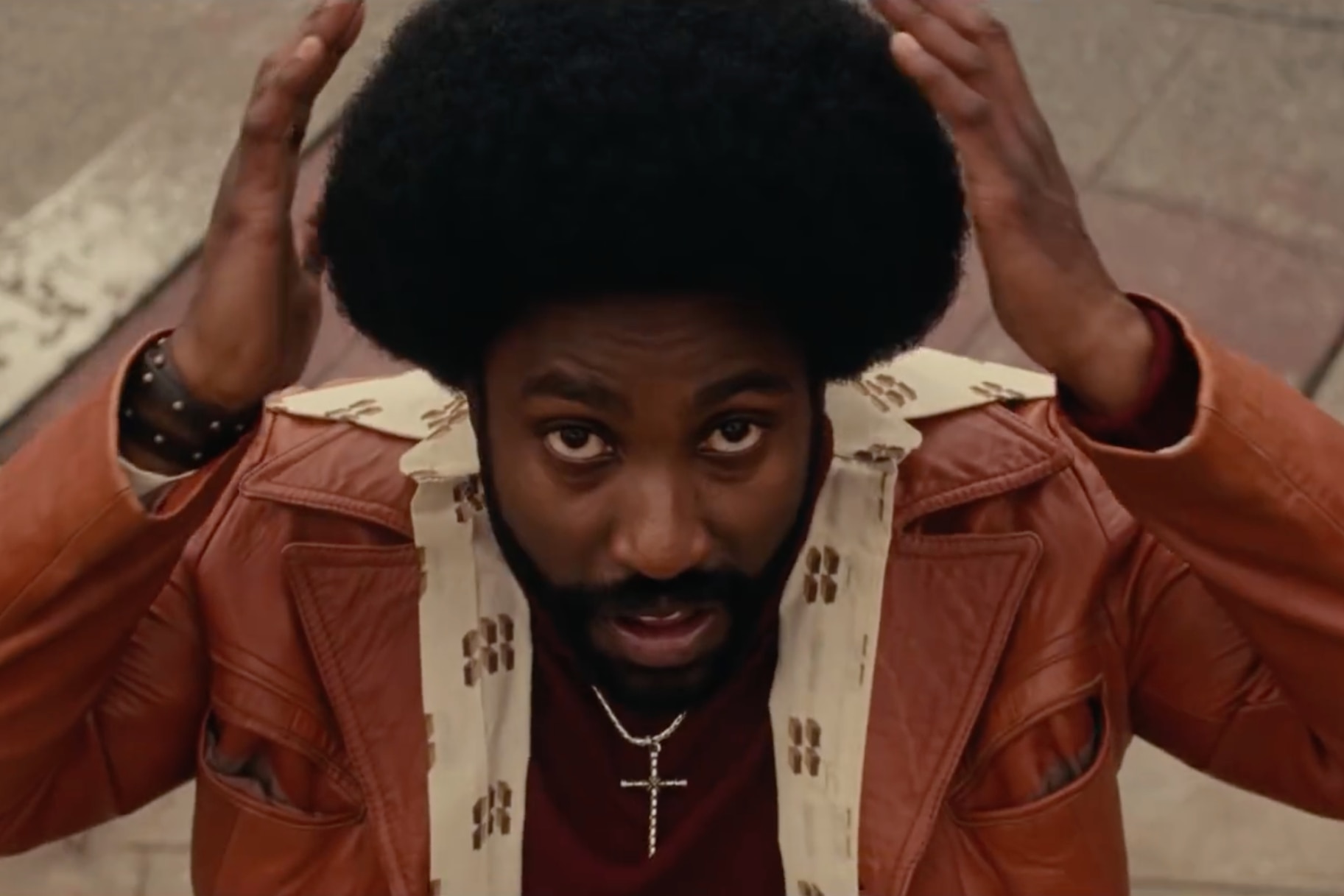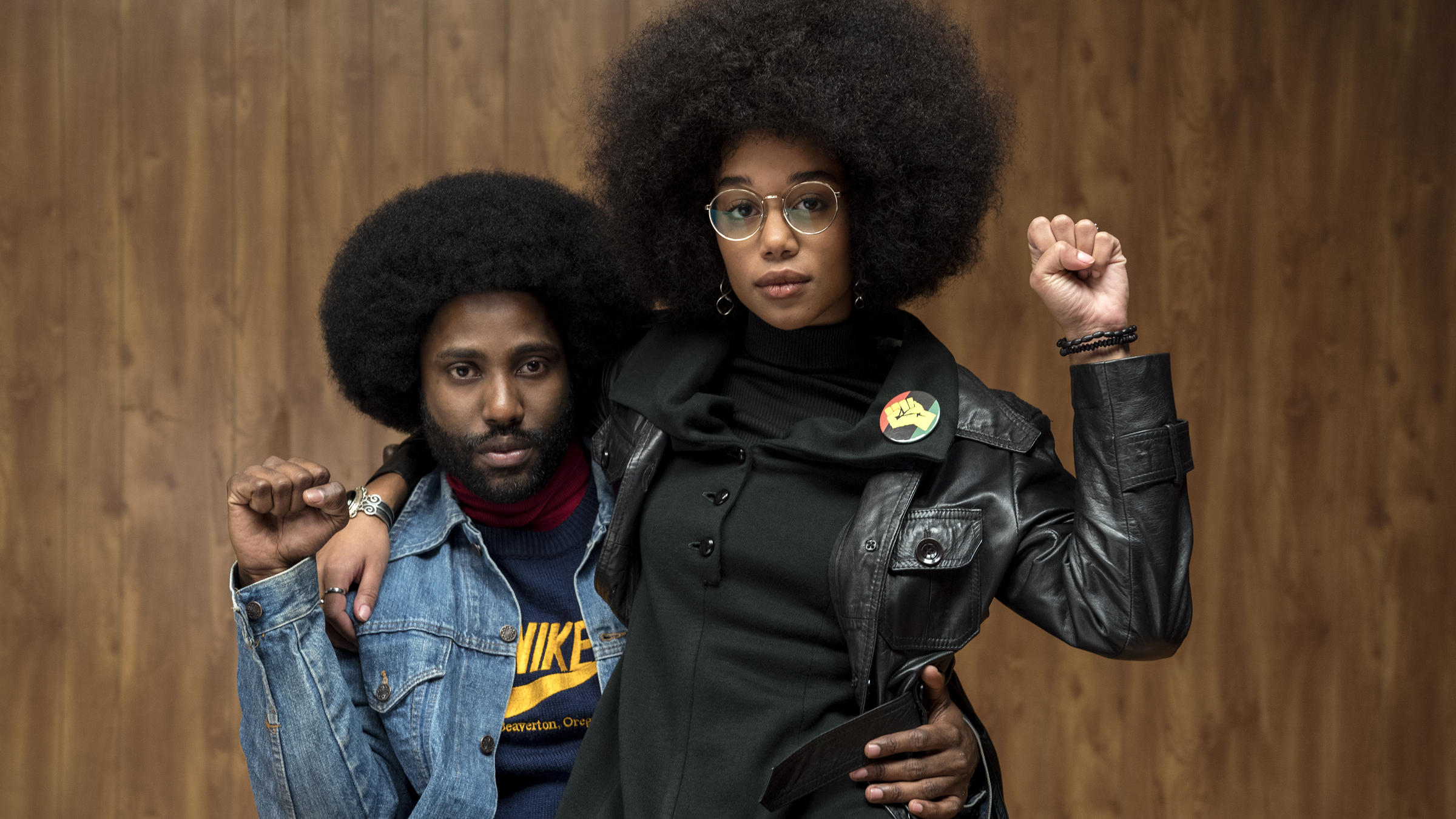by Tyra Anderson

Minority representation has been a longstanding area of discussion in film. Elizabeth Haas poses four major keys to consider when examining the role of race in our media: Is the film directed by minorities, feature many minority actors, emphasize race-related social and political issues, and/or be created primarily for minority audiences (Haas 292). BlacKkKlansman follows a black man, Ron Stallworth, who joins the Colorado Springs police force in the 1970s. After his undercover assignment surveilling African Americans at a local black college, he becomes motivated to conduct an investigation and surveillance on the Ku Klux Klan with assistance from his peers including Jewish Flip Zimmerman who impersonates Stallworth’s over-the-phone charm in person by building an intense relationship with the Klan.
Spike Lee’s, BlacKkKlansman is reflective of a lineage of unjust disparities in activism, ultimately using a healthy representation of minorities in the film to emphasize the social and political race-related issues still prevalent in our communities. The film is effective in showing how powerful a movement can be through means of solidarity and peace rather than violence. Moreover, is thorough in portraying the extent endured to defeat white supremacy.
The question one must ask when viewing the politicization of our racial climate as North Americans and broader is how is BlacKkKlansman significant in empowering minority representation in both film and public reality as well as dispelling the white supremacist agenda of hatred, bigotry, and racism often achieved through force, violence, or systems of oppression? The core ideas to answer this question is director Spike Lee’s positive representation of black characters in defiance of film’s prevalent stereotypes, and the encompassment of racism’s history as it relates to the twenty-first century. Lee exemplifies the evolution of minority representation in film as he restructures the ill conceptions and notions of black people in media and in our everyday society. In BlacKkKlansman, as ambitious and dedicated the police chief was in exposing the threats of the black activists, Stallworth replicated that ambition and dedication in an attempt to expose the threats of the KKK or self-described as “the organization”.

Reclaiming the Autonomy of Defining Blackness
Spike Lee does not exploit marginalizing stereotypes of the violent, criminal or malicious black man, he reinforces the underrepresented reality of black men as intellectual and positive personalities to achieve their goals and means. This popular stereotyping is a direct translation from colonization. He shows how to address social and political issues related to minority mis- and under-representation. For example, protagonist Stallworth is a black man who rather being “anti-police” which many black men are perceived to be, he chooses to join the police force. Correspondingly, Stallworth is a well-spoken, respectful, and educated black man despite media and society portraying black men as the opposite. He even proves his awareness of this reality by affirming he is more than capable of balancing between speaking white and negro after Chief Bridges says “white people and black people speak differently,” belittling the quality of African American’s speech.
Furthermore, black activists are not violent, in fact, they arrange educational rallies and eloquent public speakers to empower black people’s success rather than means of rioting to accomplish motives. Patrice is also not the archetypal hypersexual black woman; she is pure, modest, and considers sexual advancements as inappropriate or appalling. She wants to be acknowledged and admired for her activism, strength, and wisdom, and be appreciated for her dignity and integrity as a person rather than an object or source of arousal. Viewers see this not only by her reaction of the police officer Sanders groping her but also interactions with Ture and Stallworth.
The role of film practice in imagining and forging societies is the manner in which it groups individuals to singularly define their identity. The image which appears on the big screen becomes ingrained in people’s minds and solidifies their customs, even if unfounded. For instance, Ice Cube’s classic film Friday can perpetuate the belief that black people are lazy and immoral with the comedic glamorization of poverty, drugs, and prostitution. By normalizing these images of black people, it becomes destructive and advances the belief that black people cannot be other than “hood” or “uncivilized” and when they are indeed other than those adjectives, it results in unfamiliarity and being attributed as “acting white”. The way characters are reflected in film convinces viewers of themselves and one another of not only of who they should aspire to be but as well who they innately are. Another example includes the 1995 film Ace Ventura: When Nature Calls in which Jim Carrey “goes to Africa…prevents tribes from going to war. While on the job, Ace regularly mocks the rituals and culture of the tribes,” (Complex). The consistent racist irony in films is a critical contributor to the issues surrounding minority representation; a consistency Lee resists.
Underrepresentation and misrepresentation also matter because “‘representation … signifies social existence; absence means symbolic annihilation,’ providing a clear message about the individuals valued in a culture,” (Borum Chattoo). In addition:
Diversity inclusion and representation matters because when we praise and reward certain stories or images, whether, by big box office or gold statuary, we reveal what we as a society value, the kinds of people we find interesting, the characteristics we revere and revile. (Borum Chattoo).
By allowing propaganda of blackness being immoral and whiteness being pure, or neglecting black stories altogether, as a community we are conducting a disservice and extending the lineage of 1600s practices dehumanizing black bodies into the 2010s.

Time Does Not Always Heal All
Spike Lee is not fixated on one event or one period, he highlights racist systems and behaviours in both past and present-day events to show the prevailing pattern of white supremacy and success in light of minorities’ struggle. Many directors’ visions and film premises are narrow in execution. Lee is multi-faceted in covering various walks in the relationship between whites and minorities as he highlights pains of both blacks, for example, Stallworth, and other minority groups such as Jewish, for example Flip. Not only is the victimization of African Americans exposed but the victimization of Jewish people as well. Lee does not refrain from exposing the multiple casualties of the Western sociological and political structure which maintains Eurocentric whites as the beneficiary. After a black man (Stallworth), a Jewish man (Flip), and white men (other police members such as Detective Jimmy and Sergeant Trapp) collaborate tirelessly despite their differences to complete a triumphed investigation on the Ku Klux Klan, they feel defeated to be told by Chief Bridges that any evidence must be discarded and demolished. This nose-dive plummet after such a lengthy, seemingly victorious climb perfectly reflects the hopelessness that no matter what greatness you accomplish, white supremacy will always prevail.
There are particular film genres and technologies which can be more effective for addressing issues of racism and injustice. Lee taps into the biographical adaptation genre by using the lived experience of Ron Stallworth. As a result of using realism and testimony, it is more effective in evoking pathos, ethos, and relatability as opposed to a storyline created by Lee that viewers can saturate and discredit. Viewers greater gravitate to a story, characters, or topic knowing it is raw and deeper than entertainment; mentality that Stallworth is not only a character on the screen but could be one’s neighbour. The knowledge of trials and tribulations being authentic strengthens the connection.
Lee also explores tools of music to represent togetherness such as the scene of black people dancing at the party, and dark lighting to build suspense such as when Felix directed a gun at Flip in challenging him to partake in a lie detector test and admit he is Jewish, during Kwame Ture’s speech when he promoted black power, rise, and liberty, and when the racist Colorado police officers assaulted Patrice and her friends. Some exemplary aesthetic, affective, discursive, activist and (anti)institutional strategies included in the parallel comparison between the 1970s when Stallworth’s encounter occurred, displayed throughout the film, and 2017 when the Charlottesville riots occurred, reflected at the end of the film. The leadership of David Duke is observed and footage of the USA President Donald Trump. These leaders alongside white supremacists, neo-Nazi’s, KKK, and anti-Jew, anti-black advocates using the same rhetoric, influence, and demeanours from the 1970s as present-day signifies as much as a society we want to believe we have evolved, we have much stayed the same. The need for positive growth and change to equalize all humans has not been answered accordingly and society has become comfortable in normalizing the hierarchy of oppression.
Moreover, there is a scene in BlacKkKlansman in which Stallworth is heavily assaulted and arrested by police officers in his division after tackling Connie. Despite pleading he is an innocent officer undercover who ultimately prevented a bomb planter, Connie, from escaping, he is not believed. Yet without any proof to support Connie’s claims that she is a helpless white woman who has been attacked by a monstrous black man, the officers believe that she is a victim and Stallworth is a danger. It is not until Flip arrives that Stallworth is released and officers believe he is innocent. This incident exemplifies the recurring muting of black voices and the dehumanization of black bodies. Systemic racism protects white people to be innocent until proven guilty but black people as guilty until proven innocent, which provokes a strain and mistrust on the relationship between minorities and systems of power or justice.

Conclusion
Malcolm X once said, “If you stick a knife in my back nine inches and pull it out six inches, there’s no progress. If you pull it all the way out that’s not progress. Progress is healing the wound that the blow made. And they haven’t even pulled the knife out much less heal the wound. They won’t even admit the knife is there.”
Just because a film includes black people, does not mean it is a healthy minority representation or beneficial to racial politics. Although previous black-central hit films such as Menace II Society and Boyz in The Hood may have been rich in minority representation with black directors and black casts, Spike Lee’s BlacKkKlansman is more significant in representing minorities by defying the typical black caricatures those movies exploit, and ultimately innovative in honouring the ethical injustices of the past and present through the true story of Ron Stallworth. The principle of Lee’s effectiveness of minority representation is explicit through the core points of positive representation of black characters in defiance of film’s prevalent stereotypes, and the encompassment of racism’s history as it relates to the twenty-first century. Lee succeeds in avoiding the simplification of what the black experience means or how being black appears.
Room for criticism on this project is far and few because of how impartial and multi-dimensional it is in reshaping societal standards and expectations as well as how transparent it is about activism, equality, and relationships in contrast to many other racial or political films. He does not paint all whites as bad or all whites as good, nor does he do so for blacks, the Jewish community, or any other group. In fact, one of the most inspirational elements of the film is that regardless of the lines and labels which identify us, when we unite to defeat hatred with love whether in the 1970s or in 2017, we are unstoppable. Without a doubt, Lee makes an in-depth statement about the realities of our culture as North Americans. But he does not directly claim which perspective he personally believes is right or wrong, whether white supremacy or anti-white supremacy. He utilizes real-life encounters and examples to challenge viewers to decide what they believe is right or wrong; how we want to live, lead, and be our legacy. This utilization is an example of why we must cherish art expression in its most vulnerable form. More film creators such as Get Out’s Jordan Peele are mirroring the integral artistry Lee presents.
Works Cited
Borum Chattoo, Caty. “Oscars so White: Gender, Racial, and Ethnic Diversity and Social Issues in U.S. Documentary Films (2008–2017).” Mass Communication and Society 21.3 (2018): 368-94.
Complex. “The 50 Most Racist Movies.” Complex, Complex, 6 Oct. 2017.
Jeffrey, Karima K. “Mother of a New World? Stereotypical Representations of Black Women in Three Postapocalyptic Films.” Journal of Feminist Scholarship, no. 6, 2014, pp. 1-12.
Haas, Elizabeth, et al. Projecting Politics: Political Messages in American Films. Routledge, 2015.